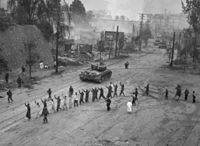Second Battle of Seoul
| Second Battle of Seoul | |||||||
|---|---|---|---|---|---|---|---|
| Part of the Korean War | |||||||
 U.S. Marines engaged in urban warfare during the battle for Seoul in late September 1950 | |||||||
| |||||||
| Belligerents | |||||||
|
| |||||||
| Commanders and leaders | |||||||
| Strength | |||||||
| 40,000 infantry |
7,000 infantry[2] unknown number of artillery, tanks and aircraft | ||||||
| Casualties and losses | |||||||
|
|
North Korea: thousands killed, wounded, and captured[4] | ||||||
The Second Battle of Seoul resulted in United Nations forces recapturing Seoul from the North Koreans in late September 1950.
Approaching Seoul
Before the battle, North Korea had just one understrength division in the city, with the majority of its forces south of the capital.

The advance on Seoul was slow and bloody after the landings at Inchon. The reason was the appearance in the Seoul area of two first-class fighting units of the Korean People's Army (KPA), the 78th Independent Infantry Regiment and 25th Infantry Brigade, about 7,000 troops in all.[7]
The KPA launched a
On the second day, vessels carrying the U.S. Army's

The next morning, the 2nd Battalion moved up to relieve a U.S. Marine battalion occupying positions on the right flank south of Seoul. Meanwhile, the 7th Division's 31st Infantry Regiment came ashore at Incheon. Responsibility for the zone south of Seoul highway passed to the 7th Division at 18:00 on September 19. The 7th Infantry Division then engaged in heavy fighting with KPA forces on the outskirts of Seoul.
The battle
The
Casualties mounted as the Americans engaged in heated
After the battle, South Korean police executed citizens and their families who were suspected communist sympathizers in what is known as the Goyang Geumjeong Cave and Namyangju massacres.[9][10]
See also
- Eugene A. Obregon, US Marine posthumously awarded the Medal of Honor for shielding a fellow Marine during the battle
- First Battle of Seoul
- Third Battle of Seoul
- Operation Ripper (Fourth Battle of Seoul)
Notes
- ^ Halberstam The Coldest Winter, p. 302.
- ISBN 9780812829778.
- ^ http://www.history.army.mil/books/korea/20-2-1/sn26.htm Archived August 9, 2020, at the Wayback Machine . Look at "THE CAPTURE OF SEOUL" Page 541 for casualty figures. Subtract Battle of Inchon casualties from the total Inchon-Seoul casualties from this source
- ^ http://www.history.army.mil/books/korea/20-2-1/sn26.htm Archived August 9, 2020, at the Wayback Machine . Page 540
- ^ Baldwin, Hanson W. (September 27, 1950), "Invasion Gamble Pays", The New York Times, p. 6, retrieved June 18, 2006
- ISBN 9780812829778.
- ISBN 9780812829778.
- ^ a b c d e f Joseph H. Alexander, Battle of the Barricades: U.S. Marines in the Recapture of Seoul, Marines in the Korean War Commemorative Series(2000).
- Hankyoreh. February 9, 2010. Retrieved November 29, 2011.
- San Diego Union-Tribune. Retrieved September 2, 2012.
References
- Halberstam, David (2007). The Coldest Winter – America and the Korean War. New York: Hyperion. ISBN 978-1-4013-0052-4.
- ISBN 0-8128-2977-8
